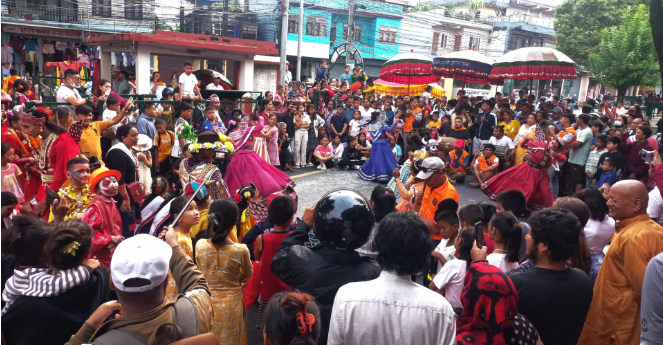The bustling trade center of Diktel Bazar came alive today with a grand performance of the traditional Lakhe dance, organized by the Diktel Bazar Social Guthi. The event saw the participation of Newar communities from various regions, including Diktel, Solma, Khale, Buipa, Kharmi, and Rajapani, showcasing the vibrant cultural heritage of the Newar people.
The grand procession of Lakhe dancers, adorned with traditional masks and accompanied by the rhythmic beats of drums and cymbals, created an atmosphere of celebration throughout the day. The performance began at Kirat Chowk and proceeded through Ratna Park, Base Camp, Tribeni Chowk, and Shankhadhar Sakhwa Chowk, before concluding at Hatdanda.
The event drew significant participation not only from the Newar community but also from other ethnic groups, reflecting a spirit of cultural unity. Vishnu Kumar Shrestha ‘Sande,’ President of Diktel Bazar Social Guthi, emphasized that the Lakhe dance exhibition was organized to promote cultural preservation and foster communal harmony. “We organize the Lakhe dance every year during the Lakhe Jatra festival, and the participation of other communities has grown, strengthening our bonds,” Shrestha remarked. The Lakhe Jatra, which began on Nag Panchami and continues until Krishna Janmashtami, features various cultural programs celebrating the rich heritage of the region.
Tank Shrestha, Coordinator of the Diktel Sarokar Kendra, echoed the importance of preserving cultural traditions. “Under the motto ‘Let’s dance Celo in Lhosar, Sili in Sakela, and Lakhe and Balan together,’ we aim to protect and promote the diverse cultural practices of all communities,” he stated. The Diktel Sarokar Kendra, formed to safeguard local traditions and advance the development of Diktel, also honored senior citizens aged 80 and above as part of this year’s festivities.
The Lakhe Jatra is a significant festival for the Newar community, celebrated since ancient times. According to Suman Shrestha, President of the Newar Mukti Morcha Khotang, the festival includes the creation of “Saparus,” effigies of cows carried through neighborhoods to honor and remember deceased ancestors. The festival is marked by religious activities, including bhajan-kirtan (devotional singing) and recitations of the Ramayana.
In conjunction with the Lakhe Jatra, a statue of the Lakhe, depicting the historic Lakhe mask crafted 163 years ago, was unveiled in Aiselukharka Rural Municipality-3, Aiselukharka Bazar. The statue, made with Rs. 1.6 million in funds provided by the rural municipality, was crafted using local materials and techniques. The unveiling ceremony also saw the renaming of the area as “Lakhe Chowk” in honor of the Newar community’s cultural heritage.
The rural municipality’s decision to establish statues representing the cultural identity of all communities is part of a broader effort to preserve and celebrate the diverse cultural heritage of Aiselukharka Bazar, where the Newar community has resided since 1918 B.S. According to Girendra Bahadur Rai, Chief of the rural municipality, this initiative underscores the commitment to honoring the history and cultural contributions of all communities in the region.






